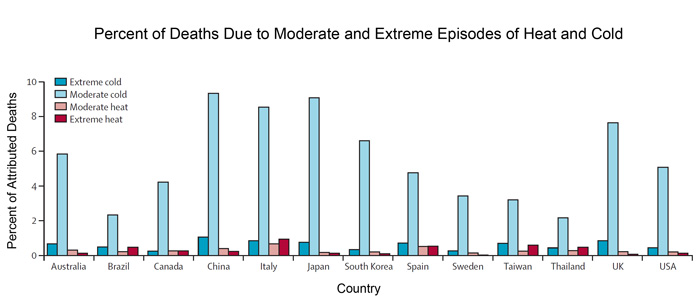| Tweet | Follow @co2science |
Paper Reviewed
Gasparrini, A., Guo, Y., Hashizume, M., Lavigne, E., Zanobetti, A., Schwartz, J., Tobias, A., Tong, S., RocklÖv, J., Forsberg, B., Leone, M, De Sario, M., Bell, M.L., Guo, Y.L.L., Wu, C.F., Kan, H., Yi, S.M., de Sousa, Z., Coelho, S. M., Saldiva, P.H., Honda, Y., Kim, H. and Armstrong, B. 2015. Mortality risk attributable to high and low ambient temperature: a multi-country observational study. The Lancet: 10.1016/S0140-6736(14)62114-0.
Which of the two temperature extremes, hot or cold, is more deadly? This is a question that has long been asked by many individuals. The latest group of scientists to do so was Gasparrini et al. (2015), who analyzed data from 384 locations scattered around the world, including the countries of Australia, Brazil, Canada, China, Italy, Japan, South Korea, Spain, Sweden, Taiwan, Thailand, the United Kingdom and the United States of America. And by fitting a standard time-series Poisson model to the data obtained for each location, while controlling for trends and day of the week, they estimated temperature-mortality associations with a distributed lag non-linear model with 21 days of lag, after which they pooled the results they obtained in a multivariate meta-regression that included country indicators and temperature averages and ranges.
This work allowed them to calculate the number of human deaths attributable to heat and cold -- defined as temperatures above and below the optimum (minimum mortality) temperature -- for both moderate and extreme temperatures, the latter being defined "using cutoffs at the 2.5th and 97.5th temperature percentiles." And what did they thereby learn?
Based on data pertaining to a total of 74,225,200 human deaths that occurred between 1985 and 2012, the 23 researchers determined that 7.71% of the lives lost were caused by non-optimum temperatures; and among this group they found that "more temperature-attributable deaths were caused by cold (7.29%) than by heat (0.42%)" (see figure below), which makes cold in excess of seventeen times more deadly than heat. And they add, in this regard, that moderate "hot and cold temperatures represented most of the total health burden." Consequently, it seems pretty clear that any successful attempt to reverse or slow any potential increase in Earth's mean global temperature would likely come at a net cost of many human lives the world over, not a savings as President Obama recently claimed (see The President's Clean Power Plan is Built Upon a Pack of Lies.

Fraction of all-cause mortality attributable to moderate and extreme hot and cold temperature by country. Extreme and moderate high and low temperatures were defined with the minimum mortality temperature and the 2.5 and 97.5th percentiles of temperature distribution as cutoffs. (Source: Gasparrini et al., 2015).




